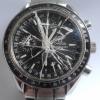When Do You Give Up On A Movement?
-
Recently Browsing
- No registered users viewing this page.
-
Topics
-
Posts
-
Agreed, this is puzzling. Can you ask questions or inspect the lots before bidding? My Boley & Leinen Reform face plate is dia. 95mm exactly. It's possible that 4 inches is a slightly too large approximation, but why then make the distinction to 3 11/16 for the sake of 8mm? If the larger ones are truly 4" then they will clash with the bed, but then I have no idea which 8mm lathe would take them. All 8mm lathes have spindle height 50mm or less, as far as I know. The spindle height is, as you say, standard 50mm for W.W.
-
I have only been a member for six years & I have found this a very friendly forum although I don’t have anything to do with watches not because I don’t like watches but because I have gout in both hands so my dexterity isn’t very good, I restore torsion clocks & occasionally other antique clocks also at 72 my eyes are not what they used to be, that is why I only post on the clock forum & the lathe forum mostly . As others have said Mark it is much appreciated that you are willing & able to do this. very many Thanks Dell
-
A local machinery auction this week is liquidating some watchmaker's equipment. Actually a truly absurd amount of it, from a machine collector's estate, making me wish I had waited a couple of months to buy my lathe because there are so many options at low prices. Anyway - there are a handful of faceplates on 8mm collet mounts up for sale and I think I can probably get one. Having never had one in hand, they seem kind of large as described though - all are listed at either 4in (101mm) or 3 11/16in (93.7mm) diameter. As I understand it, WW lathes are 50mm from spindle center to bed so it seems like the 4 inch faceplates would not have enough clearance. Could I expect the 3 11/16in to fit with a WW headstock and bed? What is a typical diameter for a faceplate? Also possible the description of "4 inches" is only a rough estimate by the auction house and not actually accurate. Example the 3 11/16": I may have answered part of this - a lot of the listings on ebay from typical American lathe tool makers are specify about 3.75 inch diameters. Still I don't see any that specify 4 inches, but I am still guessing that is an overestimate by the auction broker.
-
Buying a specific jewel for a specific movement is difficult if not impossible in most cases. cousinsuk/jewels
-





Recommended Posts